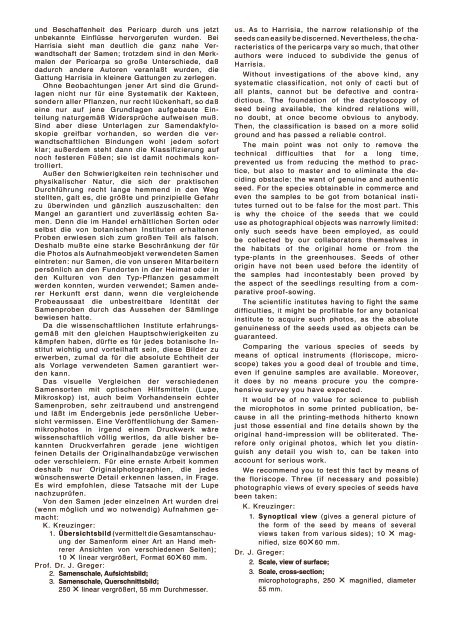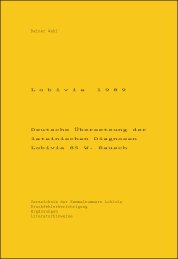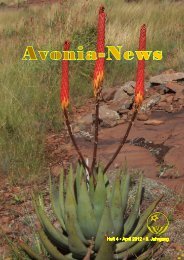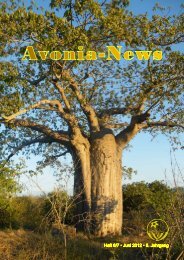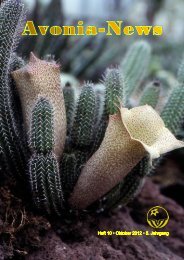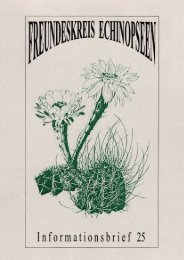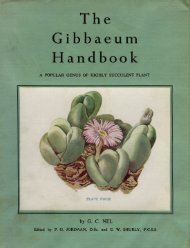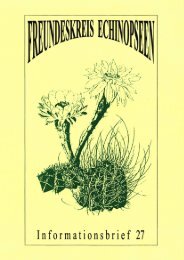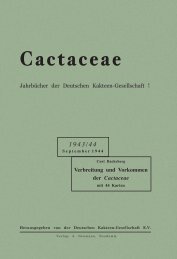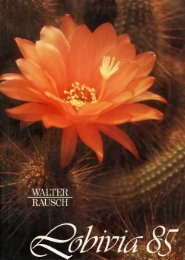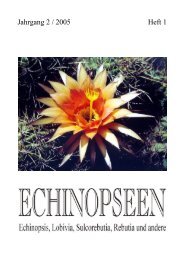Erfolgreiche ePaper selbst erstellen
Machen Sie aus Ihren PDF Publikationen ein blätterbares Flipbook mit unserer einzigartigen Google optimierten e-Paper Software.
und Beschaffenheit des Per<strong>ic</strong>arp durch uns jetzt<br />
unbekannte Einflüsse hervorgerufen wurden. Bei<br />
Harrisia s<strong>ie</strong>ht man deutl<strong>ic</strong>h d<strong>ie</strong> ganz nahe Verwandtschaft<br />
der Samen; trotzdem sind in den Merkmalen<br />
der Per<strong>ic</strong>arpa so große Untersch<strong>ie</strong>de, daß<br />
dadurch andere Autoren veranlaßt wurden, d<strong>ie</strong><br />
Gattung Harrisia in kleinere Gattungen zu zerlegen.<br />
Ohne Beobachtungen jener Art sind d<strong>ie</strong> Grundlagen<br />
n<strong>ic</strong>ht nur für eine Systematik der Kakteen,<br />
sondern aller Pflanzen, nur recht lückenhaft, so daß<br />
eine nur auf jene Grundlagen aufgebaute Einteilung<br />
naturgemäß Widersprüche aufweisen muß.<br />
Sind aber d<strong>ie</strong>se Unterlagen zur Samendakfyloskop<strong>ie</strong><br />
greifbar vorhanden, so werden d<strong>ie</strong> verwandtschaftl<strong>ic</strong>hen<br />
Bindungen wohl jedem sofort<br />
klar; außerdem steht dann d<strong>ie</strong> Klassifiz<strong>ie</strong>rung auf<br />
noch festeren Füßen; s<strong>ie</strong> ist damit nochmals kontroll<strong>ie</strong>rt.<br />
Außer den Schw<strong>ie</strong>rigkeiten rein technischer und<br />
physikalischer Natur, d<strong>ie</strong> s<strong>ic</strong>h der praktischen<br />
Durchführung recht lange hemmend in den Weg<br />
stellten, galt es, d<strong>ie</strong> größte und prinzip<strong>ie</strong>lle Gefahr<br />
zu überwinden und gänzl<strong>ic</strong>h auszuschalten: den<br />
Mangel an garant<strong>ie</strong>rt und zuverlässig echten Samen.<br />
Denn d<strong>ie</strong> im Handel erhältl<strong>ic</strong>hen Sorten oder<br />
selbst d<strong>ie</strong> von botanischen Instituten erhaltenen<br />
Proben erw<strong>ie</strong>sen s<strong>ic</strong>h zum großen Teil als falsch.<br />
Deshalb mußte eine starke Beschränkung der für<br />
d<strong>ie</strong> Photos als Aufnahmeobjekt verwendeten Samen<br />
eintreten: nur Samen, d<strong>ie</strong> von unseren Mitarbeitern<br />
persönl<strong>ic</strong>h an den Fundorten in der Heimat oder in<br />
den Kulturen von den Typ‐Pflanzen gesammelt<br />
werden konnten, wurden verwendet; Samen anderer<br />
Herkunft erst dann, wenn d<strong>ie</strong> vergle<strong>ic</strong>hende<br />
Probeaussaat d<strong>ie</strong> unbestreitbare Identität der<br />
Samenproben durch das Aussehen der Sämlinge<br />
bew<strong>ie</strong>sen hatte.<br />
Da d<strong>ie</strong> wissenschaftl<strong>ic</strong>hen Institute erfahrungsgemäß<br />
mit den gle<strong>ic</strong>hen Hauptschw<strong>ie</strong>rigkeiten zu<br />
kämpfen haben, dürfte es für jedes botanische Institut<br />
w<strong>ic</strong>htig und vorteilhaft sein, d<strong>ie</strong>se Bilder zu<br />
erwerben, zumal da für d<strong>ie</strong> absolute Echtheit der<br />
als Vorlage verwendeten Samen garant<strong>ie</strong>rt werden<br />
kann.<br />
Das visuelle Vergle<strong>ic</strong>hen der versch<strong>ie</strong>denen<br />
Samensorten mit optischen Hilfsmitteln (Lupe,<br />
Mikroskop) ist, auch beim Vorhandensein echter<br />
Samenproben, sehr zeitraubend und anstrengend<br />
und läßt im Endergebnis jede persönl<strong>ic</strong>he Uebers<strong>ic</strong>ht<br />
vermissen. Eine Veröffentl<strong>ic</strong>hung der Samenmikrophotos<br />
in irgend einem Druckwerk wäre<br />
wissenschaftl<strong>ic</strong>h völlig wertlos, da alle bisher bekannten<br />
Druckverfahren gerade jene w<strong>ic</strong>htigen<br />
feinen Details der Originalhandabzüge verwischen<br />
oder verschle<strong>ie</strong>rn. Für eine ernste Arbeit kommen<br />
deshalb nur Originalphotograph<strong>ie</strong>n, d<strong>ie</strong> jedes<br />
wünschenswerte Detail erkennen lassen, in Frage.<br />
Es wird empfohlen, d<strong>ie</strong>se Tatsache mit der Lupe<br />
nachzuprüfen.<br />
Von den Samen jeder einzelnen Art wurden drei<br />
(wenn mögl<strong>ic</strong>h und wo notwendig) Aufnahmen gemacht:<br />
K. Kreuzinger:<br />
1. Übers<strong>ic</strong>htsbild (vermittelt d<strong>ie</strong> Gesamtanschauung<br />
der Samenform einer Art an Hand mehrerer<br />
Ans<strong>ic</strong>hten von versch<strong>ie</strong>denen Seiten);<br />
10 × linear vergrößert, Format 60× 60 mm.<br />
Prof. Dr. J. Greger:<br />
2. Samenschale, Aufs<strong>ic</strong>htsbild;<br />
3. Samenschale, Querschnittsbild;<br />
250 × linear vergrößert, 55 mm Durchmesser.<br />
us. As to Harrisia, the narrow relationship of the<br />
seeds can easily be discerned. Nevertheless, the characterist<strong>ic</strong>s<br />
of the per<strong>ic</strong>arps vary so much, that other<br />
authors were induced to subdivide the genus of<br />
Harrisia.<br />
Without investigations of the above kind, any<br />
systemat<strong>ic</strong> classif<strong>ic</strong>ation, not only of cacti but of<br />
all plants, cannot but be defective and contrad<strong>ic</strong>tious.<br />
The foundation of the dactyloscopy of<br />
seed being available, the kindred relations will,<br />
no doubt, at once become obvious to anybody.<br />
Then, the classif<strong>ic</strong>ation is based on a more solid<br />
ground and has passed a reliable control.<br />
The main point was not only to remove the<br />
techn<strong>ic</strong>al diff<strong>ic</strong>ult<strong>ie</strong>s that for a long time,<br />
prevented us from reducing the method to pract<strong>ic</strong>e,<br />
but also to master and to eliminate the deciding<br />
obstacle: the want of genuine and authent<strong>ic</strong><br />
seed. For the spec<strong>ie</strong>s obtainable in commerce and<br />
even the samples to be got from botan<strong>ic</strong>al institutes<br />
turned out to be false for the most part. This<br />
is why the cho<strong>ic</strong>e of the seeds that we could<br />
use as photograph<strong>ic</strong>al objects was narrowly limited:<br />
only such seeds have been employed, as could<br />
be collected by our collaborators themselves in<br />
the habitats of the original home or from the<br />
type‐plants in the greenhouses. Seeds of other<br />
origin have not been used before the identity of<br />
the samples had incontestably been proved by<br />
the aspect of the seedlings resulting from a comparative<br />
proof‐sowing.<br />
The sc<strong>ie</strong>ntif<strong>ic</strong> institutes having to fight the same<br />
diff<strong>ic</strong>ult<strong>ie</strong>s, it might be profitable for any botan<strong>ic</strong>al<br />
institute to acquire such photos, as the absolute<br />
genuineness of the seeds used as objects can be<br />
guaranteed.<br />
Comparing the various spec<strong>ie</strong>s of seeds by<br />
means of opt<strong>ic</strong>al instruments (floriscope, m<strong>ic</strong>roscope)<br />
takes you a good deal of trouble and time,<br />
even if genuine samples are available. Moreover,<br />
it does by no means procure you the comprehensive<br />
survey you have expected.<br />
It would be of no value for sc<strong>ie</strong>nce to publish<br />
the m<strong>ic</strong>rophotos in some printed publ<strong>ic</strong>ation, because<br />
in all the printing‐methods hitherto known<br />
just those essential and fine details shown by the<br />
original hand‐impression will be obliterated. Therefore<br />
only original photos, wh<strong>ic</strong>h let you distinguish<br />
any detail you wish to, can be taken into<br />
account for serious work.<br />
We recommend you to test this fact by means of<br />
the floriscope. Three (if necessary and possible)<br />
photograph<strong>ic</strong> v<strong>ie</strong>ws of every spec<strong>ie</strong>s of seeds have<br />
been taken:<br />
K. Kreuzinger:<br />
1. Synopt<strong>ic</strong>al v<strong>ie</strong>w (gives a general p<strong>ic</strong>ture of<br />
the form of the seed by means of several<br />
v<strong>ie</strong>ws taken from various sides); 10 × magnif<strong>ie</strong>d,<br />
size 60× 60 mm.<br />
Dr. J. Greger:<br />
2. Scale, v<strong>ie</strong>w of surface;<br />
3. Scale, cross‐section;<br />
m<strong>ic</strong>rophotographs, 250 × magnif<strong>ie</strong>d, diameter<br />
55 mm.


